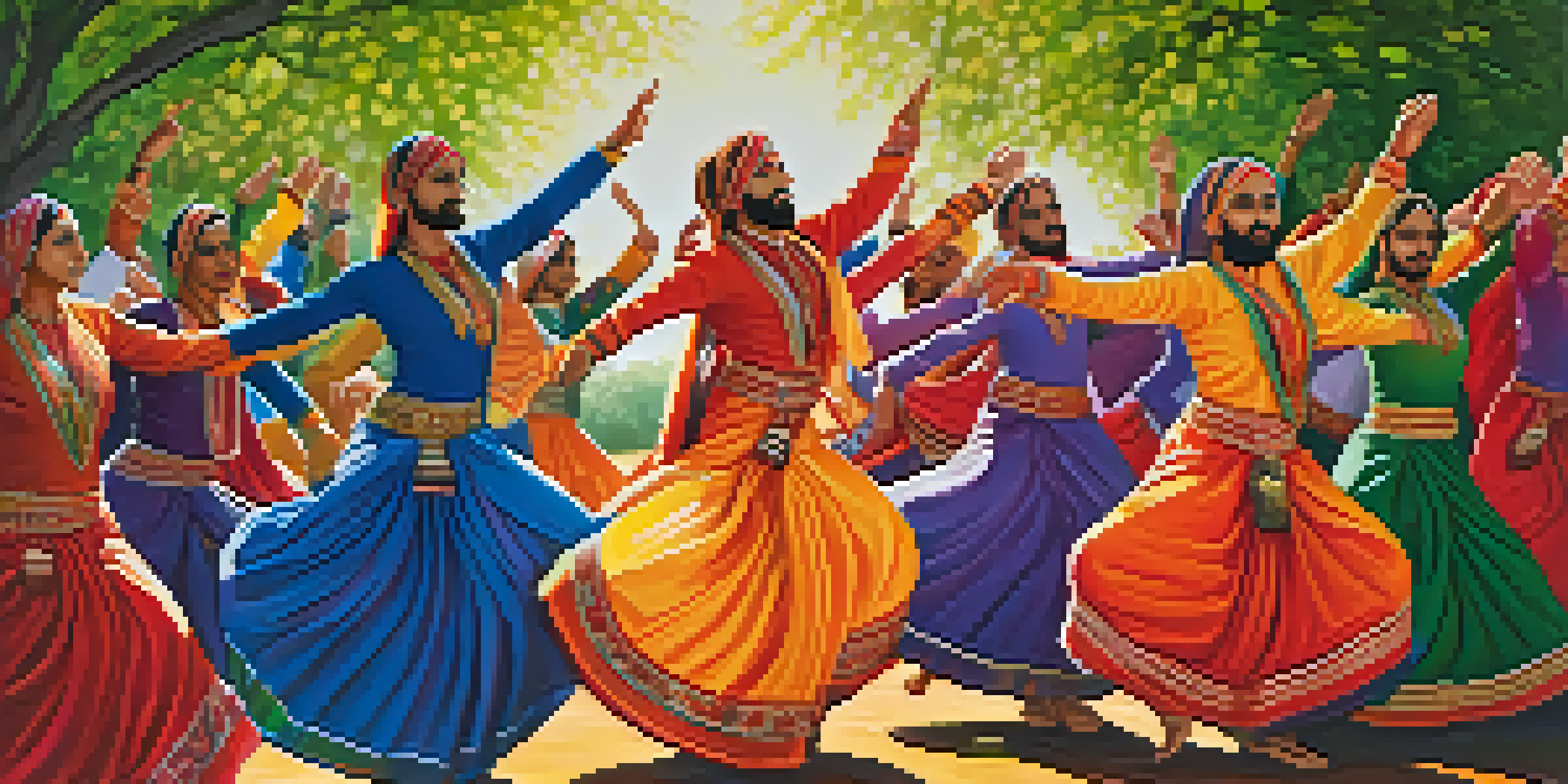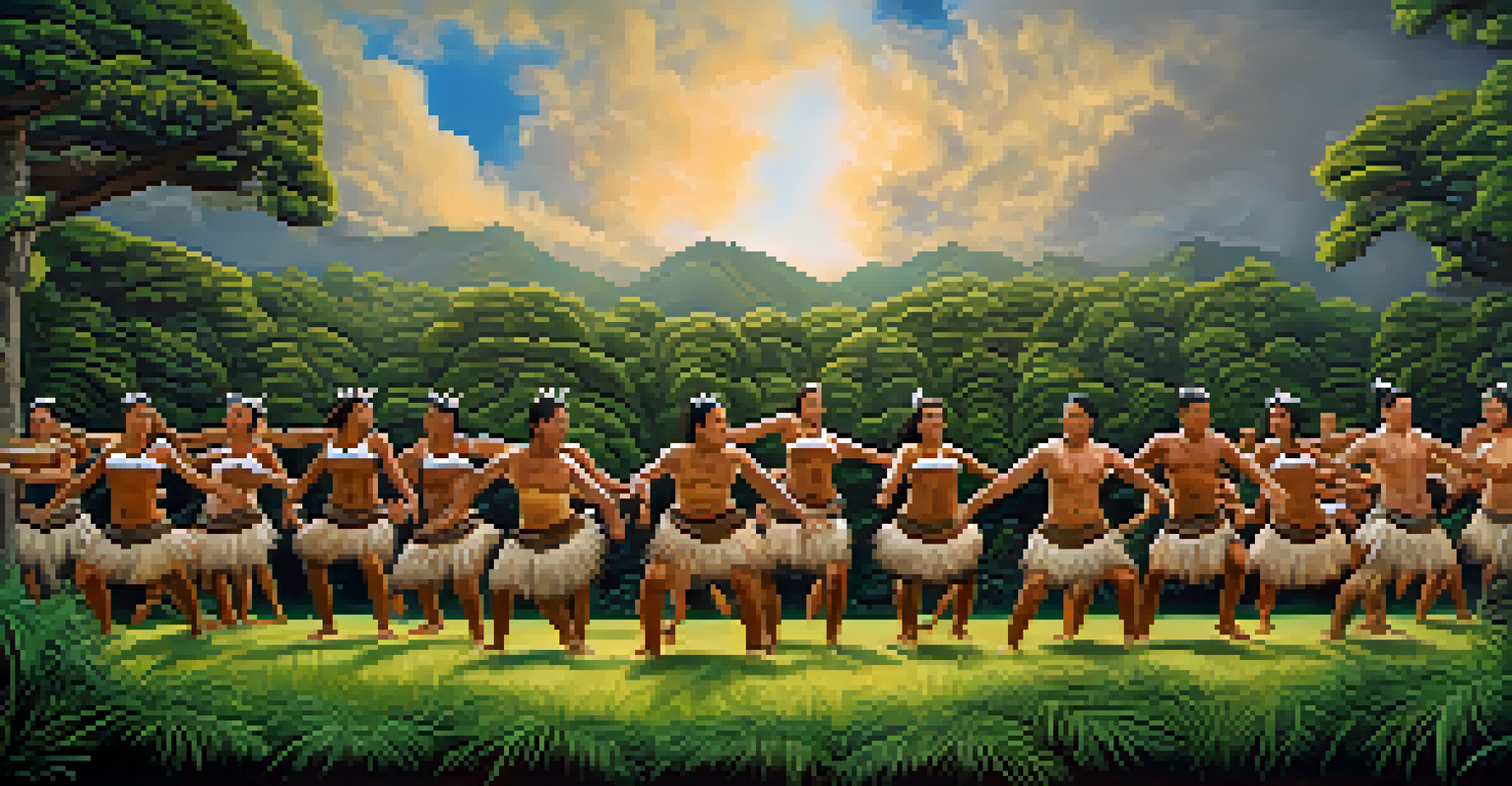Exploring Traditional Folk Dances Across Global Cultures

Folk Dances: A Window into Cultural Heritage
Folk dances are more than just rhythmic movements; they embody the spirit and history of a community. Every step and twirl tells a story, connecting generations through shared traditions. For instance, the traditional Irish jig showcases not only a lively dance but also the rich narrative of Irish culture and its resilience.
Dance is the hidden language of the soul.
These dances often arise from the daily lives and experiences of the people, making them a reflection of societal values and celebrations. In countries like India, folk dances like Bhangra celebrate the harvest, infusing joy and gratitude into each performance. Such cultural expressions remind us of our roots and the importance of community.
As we explore different folk dances, we recognize how these art forms serve as a universal language, transcending barriers and fostering understanding. They invite us to dance along, to feel the rhythm of another's joy and sorrow, and to appreciate the diverse tapestry of human experience.
The Vibrant Flamenco: Dance of Passion and Emotion
Flamenco, originating from the Andalusian region of Spain, is a passionate dance that embodies deep emotion and storytelling. It's characterized by its intricate footwork, expressive hand movements, and vibrant costumes, with each element contributing to the overall narrative. Dancers often perform with a unique intensity that captivates audiences, drawing them into the performance.

Traditionally, Flamenco was a dance of the marginalized, showcasing the struggles and triumphs of the Romani people in Spain. Over the years, it has evolved, incorporating various influences while staying true to its roots. The music, often featuring guitars and claps, complements the dance, creating a powerful synergy that resonates with viewers.
Folk Dances Reflect Cultural Heritage
Folk dances serve as vibrant expressions of community spirit, embodying the history and traditions of various cultures.
Flamenco performances are not just about the dance; they are an experience, combining music, song, and movement into a celebration of life. Whether performed in an intimate gathering or on a grand stage, Flamenco invites everyone to feel the rhythm and passion of its heritage.
The Grace of Ballet Folklórico: A Mexican Treasure
Ballet Folklórico is a stunning representation of Mexico's rich cultural heritage, combining traditional dance with vibrant costumes and live music. Each region in Mexico has its unique style, making this dance form a colorful mosaic of the country's history. For example, the Jalisco style features charro outfits, showcasing the essence of Mexican ranch life.
The dance is a poem of which each movement is a word.
The performances often tell stories of historical events, folklore, and regional customs, allowing audiences to gain insight into the diverse Mexican culture. Dancers, often trained in classical ballet, execute intricate movements that blend elegance with traditional elements, creating a captivating spectacle. The lively mariachi music enhances the experience, inviting the audience to engage with the performance.
Ballet Folklórico serves not only as entertainment but also as an educational tool, preserving and promoting Mexico's cultural identity. It fosters pride within communities, encouraging younger generations to learn and carry on these vibrant traditions.
The Energetic Bhangra: A Celebration of Life in India
Bhangra is a lively folk dance originating from the Punjab region of India, traditionally performed during harvest festivals. With its energetic beats and vibrant movements, Bhangra celebrates joy, community, and the abundance of life. The dance is characterized by its rhythmic footwork and infectious energy that often leads to spontaneous participation from onlookers.
Originally, Bhangra was a way for farmers to celebrate the harvest and express their gratitude to the earth. Over time, it has evolved into a popular dance form, merging traditional elements with modern influences, making it a staple at weddings and festivals. The colorful attire worn by dancers adds to the visual feast, making Bhangra a true celebration of culture.
Flamenco: A Dance of Passion
Flamenco combines intricate movements and music to tell deep emotional stories, rooted in the struggles of the Romani people.
Today, Bhangra has gained international popularity, with workshops and competitions held worldwide. This dance not only brings people together but also promotes cultural exchange, allowing others to experience the joy and vibrancy of Punjabi traditions.
The Rhythmic Hula: Hawaiian Culture in Motion
Hula is a traditional Hawaiian dance that tells stories through expressive movements and chants, known as mele. It connects the dancers to their ancestors and the natural world, embodying the spirit of Aloha. Each gesture has a specific meaning, allowing dancers to convey emotions and narratives that are deeply rooted in Hawaiian culture.
Historically, Hula was performed during religious ceremonies and celebrations, preserving the history and traditions of the Hawaiian people. The intricate footwork and graceful movements are accompanied by live music, often featuring instruments like the ukulele and ipu (gourd drum). This harmonious blend creates a captivating atmosphere that draws audiences into the heart of Hawaiian culture.
In modern times, Hula has gained global recognition, often seen in performances across the world. While it has evolved, the essence of Hula remains a vital part of Hawaii's cultural identity, reminding us of the importance of storytelling and connection to our roots.
The Traditional Kathak: Expressive Dance of North India
Kathak is one of the classical dance forms of India, originating from the northern regions and characterized by intricate footwork and expressive storytelling. Dancers often portray stories from Hindu mythology, drawing the audience into a world of emotion and drama. The rhythmic sounds of bells (ghungroo) accentuate each movement, creating a mesmerizing auditory experience.
Traditionally performed by wandering bards known as Kathakars, this dance form has evolved over centuries, influenced by Mughal culture and the courts of North India. Today, it blends classical techniques with modern interpretations, showcasing the versatility and richness of Indian culture. Each performance is a dialogue between the dancer and the audience, inviting them to interpret the emotions conveyed.
Bhangra Celebrates Life and Community
Bhangra is an energetic dance from Punjab that celebrates harvests and brings people together through joyful expression.
Kathak serves not only as a form of entertainment but also as a means of preserving cultural heritage. Through its intricate movements and storytelling, it connects people to their history, reminding us of the beauty and depth of diverse artistic expressions.
The Majestic Maori Haka: A Dance of Unity and Strength
The Haka is a traditional war dance of the Māori people of New Zealand, renowned for its powerful movements and vocal expressions. Often performed in a group, the Haka serves as a display of unity, strength, and identity, conveying messages of pride and resilience. It is commonly associated with rituals and events, often performed before sports matches, creating a sense of connection among participants and spectators alike.
Each Haka has its unique meaning, often telling stories of ancestors, celebrating victories, or commemorating significant events. The dance incorporates vigorous foot stomping, rhythmic chanting, and expressive facial gestures, all of which amplify the emotional impact of the performance. This captivating display invites onlookers to share in the experience, making it a powerful form of cultural expression.

In recent years, the Haka has gained international recognition, symbolizing Māori culture and heritage. It serves as a reminder of the importance of preserving indigenous traditions while fostering respect and understanding across cultures.